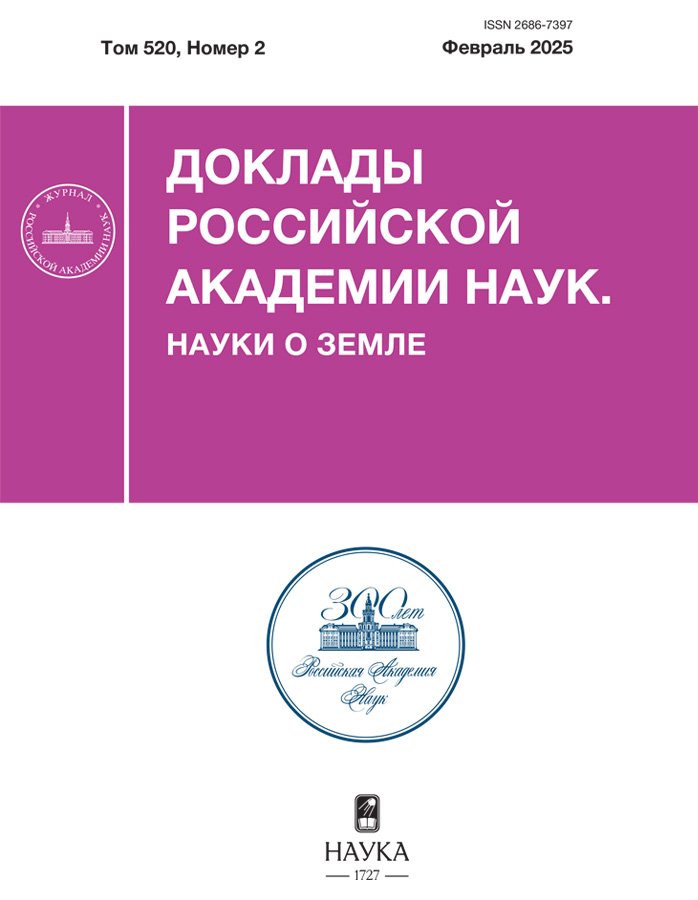Age and geodynamic position of ophiolites of the Kurtushiba Ridge of the Western Sayan
- 作者: Mongush A.A.1, Gusev N.I.2, Oydup C.K.1, Kadyr-ool C.O.1, Hertek C.M.1, Lesnov F.P.3, Druzhkova E.K.1
-
隶属关系:
- Tuvinian Institute for Exploration of Natural Resources, Siberian Branch of the Russian Academy of Sciences
- A.P. Karpinsky Russian Geological Research Institute
- V.S. Sobolev Institute of Geology and Mineralogy, Siberian Branch of the Russian Academy of Sciences
- 期: 卷 520, 编号 2 (2025)
- 页面: 185-192
- 栏目: GEOLOGY
- ##submission.dateSubmitted##: 17.06.2025
- ##submission.dateAccepted##: 17.06.2025
- ##submission.datePublished##: 04.09.2025
- URL: https://cardiosomatics.ru/2686-7397/article/view/685059
- DOI: https://doi.org/10.31857/S2686739725020017
- EDN: https://elibrary.ru/GEBXRG
- ID: 685059
如何引用文章
详细
The composition of metadiabase dykes, metabasalt lavas and plagiogranite veins of ophiolite association in the upper reaches of the Koiard River of the Kurtushiba Ridge has been studied. The results of geochemical studies show that these ophiolites are characterized by N-MORB+IAB–like composition. The U-Pb age of the ophiolites is 569±6 Ma. The ophiolites of the Kurtushiba Ridge, along with the ophiolites of the Shatsky massif in Western Tuva and the island-arc complexes of the Ondum subzone, were formed simultaneously or close in time, ~578–569 Ma, at the early stage of evolution of the Tannuola-Khamsara paleo-island arc.
全文:
作者简介
A. Mongush
Tuvinian Institute for Exploration of Natural Resources, Siberian Branch of the Russian Academy of Sciences
编辑信件的主要联系方式.
Email: amongush@inbox.ru
俄罗斯联邦, Kyzyl
N. Gusev
A.P. Karpinsky Russian Geological Research Institute
Email: amongush@inbox.ru
俄罗斯联邦, St. Petersburg
C. Oydup
Tuvinian Institute for Exploration of Natural Resources, Siberian Branch of the Russian Academy of Sciences
Email: amongush@inbox.ru
俄罗斯联邦, Kyzyl
C. Kadyr-ool
Tuvinian Institute for Exploration of Natural Resources, Siberian Branch of the Russian Academy of Sciences
Email: amongush@inbox.ru
俄罗斯联邦, Kyzyl
C. Hertek
Tuvinian Institute for Exploration of Natural Resources, Siberian Branch of the Russian Academy of Sciences
Email: amongush@inbox.ru
俄罗斯联邦, Kyzyl
F. Lesnov
V.S. Sobolev Institute of Geology and Mineralogy, Siberian Branch of the Russian Academy of Sciences
Email: amongush@inbox.ru
俄罗斯联邦, Novosibirsk
E. Druzhkova
Tuvinian Institute for Exploration of Natural Resources, Siberian Branch of the Russian Academy of Sciences
Email: amongush@inbox.ru
俄罗斯联邦, Kyzyl
参考
- Ярмолюк В.В., Коваленко В.И., Ковач В.П., Рыцк Е.Ю., Козаков И.К., Котов А.Б., Сальникова Е.Б. Ранние стадии формирования Палео-Азиатского океана: результаты геохронологических, изотопных и геохимических исследований позднерифейских и венд-кембрийских комплексов Центрально-Азиатского складчатого пояса // Доклады академии наук. 2006. Т. 410. № 5. С. 657–662.
- Берзин Н.А., Кунгурцев Л.В. Геодинамическая интерпретация геологических комплексов Алтае-Саянской области // Геология и геофизика. 1996. Т. 37. № 1. С. 63–81.
- Куренков С.А., Диденко А.Н., Симонов В.А. Геодинамика палеоспрединга. М.: ГЕОС, 2002. 294 с.
- Волкова Н.И., Ступаков С.И., Бабин Г.А., Руднев С.Н., Монгуш А.А. Подвижность редких элементов при субдукционном метаморфизме (на примере глаукофановых сланцев Куртушибинского хребта, Западный Саян) // Геохимия. 2009. Т. 47. № 4. С. 401–414.
- Добрецов Н.Л., Пономарева Л.Г. Офиолиты и глаукофановые сланцы Западного Саяна и Куртушибинского пояса // Петрология и метаморфизм древних офиолитов (на примере Полярного Урала и Западного Саяна). Новосибирск: Наука, 1977. С. 128–156.
- Mongush A.A., Olschewski P. A new look at the geodynamic development of the Ediacaran–early Cambrian forearc basalts of the Tannuola-Khamsara Island Arc (Central Asia, Russia): Conclusions from geological, geochemical, and Nd-isotope data // Open Geosciences. 2024. 16: 20220586.
- Добрецов Н.Л., Буслов М.М. Позднекембрийско-ордовикская тектоника и геодинамика Центральной Азии // Геология и геофизика. 2007. Т. 48. № 1. С. 186–201.
- Дятлова И.Н., Бублик А.И., Шарифулин С.К. Месторождения нефрита Западного Саяна // Природные ресурсы, среда и общество. 2023. № 2. С. 14–33.
- Монгуш А.А. Офиолиты Западного Саяна и Западной Тувы – автохтонные комплексы Саяно-Тувинской преддуговой зоны V-Є1 островной дуги Палеоазиатского океана / Геодинамическая эволюция литосферы Центрально-Азиатского подвижного пояса (от океана к континенту): Материалы совещания. Иркутск: ИЗК СО РАН, 2017. С. 194‒196.
- Руднев С.Н., Мальковец В.Г., Белоусова Е.А., Туркина О.М., Семенова Д.В. Изотопный Lu-Hf состав циркона и источники магм венд-раннепалеозойских гранитоидов Тувы (на примере Каахемского и Восточно-Таннуольского батолитов) // Геология и геофизика. 2020. Т. 61. № 10. С. 1331–1355.
- Cabanis B., Lecolle M. Le diagramme La/10 – Y/15 – Nb/8: Un outil pour la discrimination des series volcaniques et en evidence des mélange et/ot de vontaminationcrustale // ComptesRendus de l’Académie des Sciences. Série II. 1989. V. 309. P. 2023‒2029.
- Condie K.C. High field strength element rations in Archean базальты: a window to evolving sources of mantle plumes? // Lithos. 2005. V. 79. P. 491–504.
- Agrawal S., Guevara M., Verma S.P. Tectonic Discrimination of Basic and Ultrabasic Volcanic Rocks through Log-Transformed Ratios of Immobile Trace Elements. International Geology Review, 2008. V. 50(12). P. 1057–1079.
- Монгуш А.А. Геологическое положение, геохимический и Sm-Nd изотопный состав офиолитов Саяно-Тувинской преддуговой зоны // Известия Иркутского госуниверситета. Серия “Науки о Земле”. 2019. Т. 30. С. 56–75.
- Furnes H., Safonova I. Ophiolites of the Central Asian Orogenic Belt: Geochemical and petrological characterization and tectonic settings // Geoscience Frontiers. 2019. V. 10(4). P. 1255–1284.
- Беззубцев В.В., Перфилова О.Ю. Государственная геологическая карта Российской Федерации. Масштаб 1 : 1 000 000 (третье поколение). Серия Алтае-Саянская. Лист N-46 (Абакан). СПб.: ВСЕГЕИ, 2008.
- Corfu F., Hanchar J.M., Hoskin P.W.O., Kinny P. Atlas of Zircon Textures // Mineralogy and Geochemistry. 2003, V. 53. P. 469–500.
- Монгуш А.А., Лебедев В.И., Травин А.В., Ярмолюк В.В. Офиолиты Западной Тувы – фрагменты поздневендской островной дуги Палеоазиатского океана // ДАН. 2011. Т. 438. № 6. С. 796–802.
补充文件













